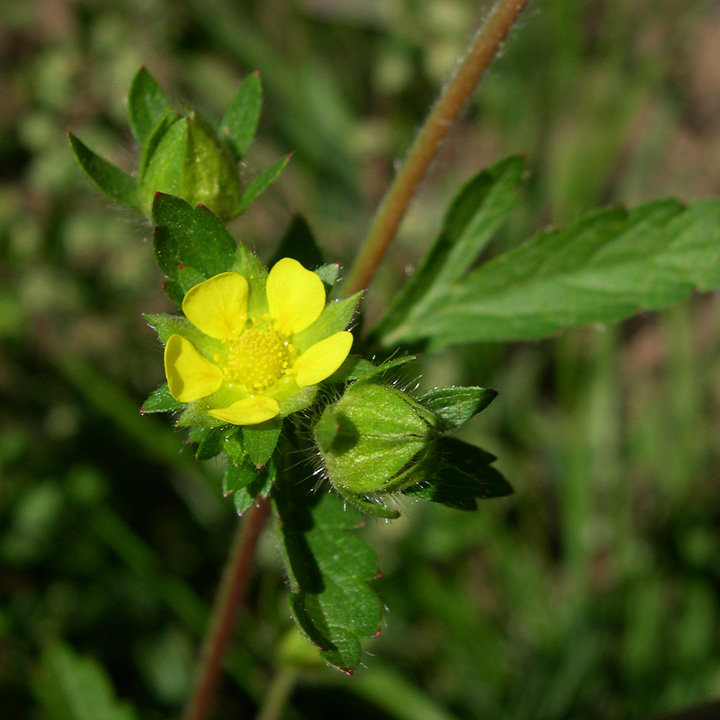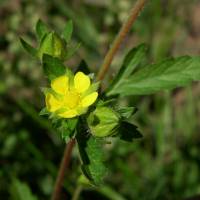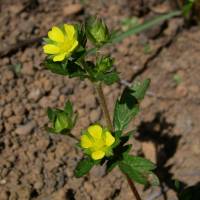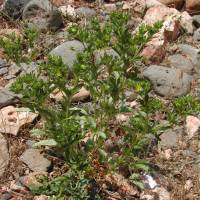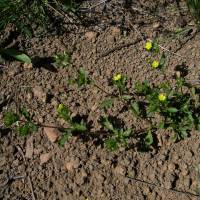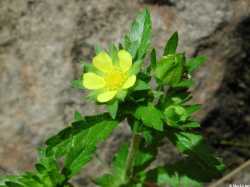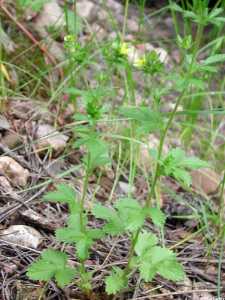Potentilla norvegica is a prostrate herb with small usually single or trifoliate leaves and yellow flowers. It is found on disturbed ground at middle elevation.
This species is a frequent to common weed throughout the state. It is found in almost all kinds of habitats but it is not frequent in certain bottomlands. I have specimens from roadsides, cultivated and fallow fields, pastures, open woods, dry dunes, and a dense tamarack. bog. It is a pernicious weed, especially in clover fields because its seed are separated from clover seed only with difficulty.
General: Annual, biennial, or short-lived perennial, 10-70 cm tall; stems few to several, clustered, erect or ascending, simple or branched in the upper part; herbage hirsute, the hairs stiff, spreading; taproot slender.
Leaves: Mostly cauline, alternate, trifoliate, leaflets broadly oblanceolate to obovate, 1.5-4 cm long, the terminal leaflet longer than the lateral pair and borne on a petiolule, surfaces spreading-hirsute, paler beneath, margin shallowly lobed, toothed, or coarsely crenate; stipules ovate, margins entire to toothed; petiole 1.5-6 cm long.
Flowers: Inflorescence an open cyme, the branches ascending; flowers few to several; hypanthium shallowly cup-shaped, silky-pubescent externally; bractlets lanceolate, 2-5 mm long; sepals broadly lanceolate, 4-6.5 mm long; petals obovate, 4-6 mm long, yellow; stamens about 20; pistils numerous, the style 1.7-2.3 mm long; flowers June- September.
Fruits: Achene, 0.8-1.1 mm long, light brown, often becoming slightly wrinkled with maturity.
Ecology: Meadows, streambanks, lake and pond margins, ditches; 1800-2900 m (6000-9500 ft); Apache, Coconino, Greenlee, and Navajo counties; widely distributed throughout North America.
Notes: Potentilla biennis (biennial cinquefoil) is very similar, but the herbage is glandular-pubescent, the hairs viscid- villous, soft; stamens are about 10; achenes are 0.5-0.7 mm long, smooth, yellowish; and the style is 0.5-0.7 mm long. Potentilla rivalis (brook cinquefoil, river cinquefoil) has villous herbage, not glandular; leaves are trifoliate above, 5-foliate below. Both P. biennis and P. rivalis occur in similar habitats as P. norvegica. Potentilla nivea (snow cinquefoil) is perennial, mat- or cushion-forming, the caudex much-branched; leaves are mostly basal, usually forming a well-developed rosette, green to gray-green and spreading-hirsute above, densely white-tomentose beneath, margins of the leaflets coarsely toothed. It occurs on alpine to subalpine slopes of the San Francisco Peaks. A cold tea of P. norvegica is used by the Navajo to lessen pain.
Editor: Springer et al. 2008
Stout, leafy annual to short-lived perennial, the stem mostly branched and many-fld, hirsute below, subtomentose above; lfls 3, elliptic to broadly obovate, to 8 cm, crenate; fls yellow, nearly 1 cm wide, the pet nearly as long as the sep; bractlets and sep lance- ovate, subequal at anthesis, the sep accrescent in fr and to 15 mm; stamens usually 20; anthers 0.3 mm; achenes flattened, 1 mm, usually marked with curved longitudinal ridges; 2n=42, 56, 70. In a wide variety of habitats; circumboreal, s. in Amer. to S.C., Tenn., Tex., and Calif. June-Aug. The native American plants tend to differ slightly from the European ones, and have been segregated as P. monspeliensis L. or P. norvegica var. hirsuta (Michx.) Torr. & A. Gray, but no clear distinction can be made, and the Eurasian phase has also apparently been intr. into our range.
Gleason, Henry A. & Cronquist, Arthur J. 1991. Manual of vascular plants of northeastern United States and adjacent Canada. lxxv + 910 pp.
©The New York Botanical Garden. All rights reserved. Used by permission.


